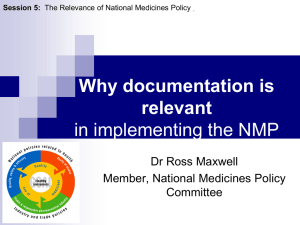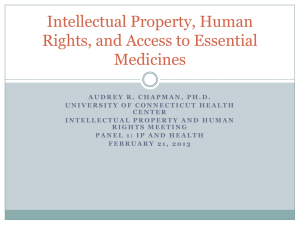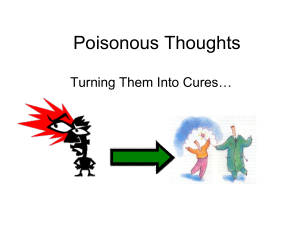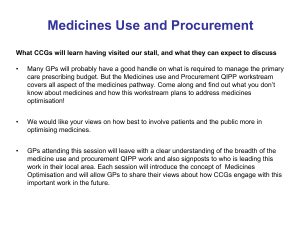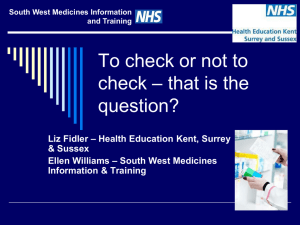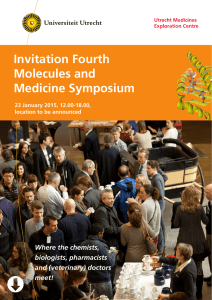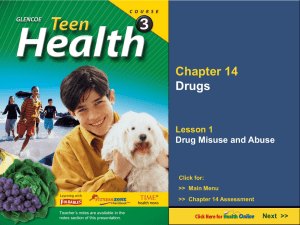832-Bigdeli-_b
advertisement
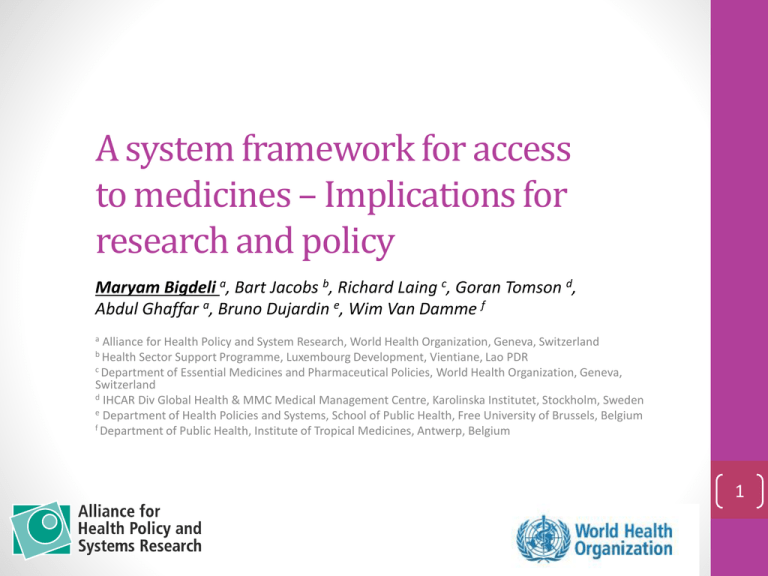
A system framework for access to medicines – Implications for research and policy Maryam Bigdeli a, Bart Jacobs b, Richard Laing c, Goran Tomson d, Abdul Ghaffar a, Bruno Dujardin e, Wim Van Damme f a Alliance for Health Policy and System Research, World Health Organization, Geneva, Switzerland Sector Support Programme, Luxembourg Development, Vientiane, Lao PDR c Department of Essential Medicines and Pharmaceutical Policies, World Health Organization, Geneva, Switzerland d IHCAR Div Global Health & MMC Medical Management Centre, Karolinska Institutet, Stockholm, Sweden e Department of Health Policies and Systems, School of Public Health, Free University of Brussels, Belgium f Department of Public Health, Institute of Tropical Medicines, Antwerp, Belgium b Health 1 Access to medicines in LMICs • Considerable improvement in access to medicines since late 70's • Significant problems persist, especially for the poor and vulnerable populations • • • • Inadequate prescription and use Poor quality of services and medicines Unregulated informal sector High proportion of health spending in general and OOP in particular • Fragmented vertical approach to access to medicines • Disconnect between the pharmaceuticals and other health system building blocks challenges • On-going challenges: communicable diseases, neglected diseases, high burden of mother and child mortality and morbidity , constraints in system resources: human, financial etc. • New challenges: noncommunicable diseases, aging population, escalating costs, widening inequities Maryam Bigdeli - Alliance for Health Policy and Systems Research current situation 2 • Strong movement around universal coverage and social health protection • New IT capabilities and opportunities for health systems • Increased attention on the crucial role of human resources • Focus on national planning processes • Innovations in community participation and role of consumers • Increasing attention on evidence for decision making Source: Alliance for Health Policy and Systems Research, WHO. Systems Thinking for Health Systems Strengthening. 2009 Maryam Bigdeli - Alliance for Health Policy and Systems Research Opportunities "Multiple, dynamic relationships between building blocks are essential for achieving better outcomes" 3 Level of the health system I. Individual, household and community II. Health Service Delivery Source: Adapted from Hanson, K. et al., 2003. Expanding access to priority health interventions: a framework for understanding the constraints to scaling-up. Journal of International Development, 15: 1-14. Populated with access to medicines barriers identified in the literature between 2000-2010 III. Health Sector IV. Public policies cutting across sectors V. International and regional level Maryam Bigdeli - Alliance for Health Policy and Systems Research A multi-layer health system view of barriers to access to medicines 4 Barriers to access medicines I. Individual, household and community Physical barriers (geographical location, opening hours) Perceived quality of medicines and health services Inadequate health seeking behaviour and demand for medicines Inadequate use of medicines Social and cultural barriers (stigma related to poverty, ethnicity, gender, etc.) II. Health Service Delivery low quality of health services, including staff capacity and motivation, infrastructure etc. Competition between public and private health service delivery Low level of funding for service delivery Weak supply of medicines, low availability Inadequate prescription and dispensing Low quality / substandard medicines High medicine prices Weak governance of the health sector affecting all building blocks: III. Health Sector Absence of stewardship over a pluralistic health system , including private and informal health sector Absence of partnership with civil society or civil society participation in governance Weak human resources planning and capacity development Weak health information system and capacity for monitoring and evaluation Low level of funding for health, inefficiency in the use of funds, low coverage of pre-payment and social protection schemes, over-reliance on donor funding Weak governance of the pharmaceutical sector affecting all functions: Registration, selection, procurement, distribution, licensing of pharmaceutical establishments, inspection, control of medicines promotion, etc. IV. Public policies cutting across sectors Low public accountability and transparency Low priority attached to social sectors High burden of government bureaucracy Conflict between trade and economic goals for pharmaceutical markets and public health goals V. International International donors agenda, including for medicines and regional level Weak regional development and economic cooperation mechanisms Unethical use of patents and intellectual property rights Research and development not targeting disease burden in LMICs Maryam Bigdeli - Alliance for Health Policy and Systems Research Level of the health system 5 A system framework for access to medicines: the critical paradigm shifts Beyond the individual user, Inclusive of households and communities • • Vulnerability context of individuals, households and communities: natural, physical, social, human and financial capital (Obrist et al 2007) "Expert" patients : harnessing resources available at the community to support other patients or build collective networks (Van Damme et al 2008, Haines et al 2007) Maryam Bigdeli - Alliance for Health Policy and Systems Research 1. Adopting a holistic view on demand-side constraints: 6 A system framework for access to medicines: the critical paradigm shifts • Relationships between resources: medicines, health financing, human resources, health information • Relationships between medicines and service dellivery (van Olmen et al 2010) Maryam Bigdeli - Alliance for Health Policy and Systems Research 2. Considering the multiple and dynamic relationships between all building blocks of the health system 7 A system framework for access to medicines: the critical paradigm shifts 1. 2. Beyond just health sector governance Inclusive of local, national (above health sector) and international contexts Maryam Bigdeli - Alliance for Health Policy and Systems Research 3. Considering multi-layer leadership and governance: 8 9 Maryam Bigdeli - Alliance for Health Policy and Systems Research • Policies and interventions can use any entry point but should keep the wider picture in mind: What are the contextual pre-requisites for a given policy or intervention? What are the wider system effects? How will the system react? "A systems perspective can minimize the mess; many of today's problems are because of yesterday's solutions" Dr. Irene Akua Agyepong, Ghana Health Service Ministry of Health, Ghana, 2009 Maryam Bigdeli - Alliance for Health Policy and Systems Research Implications for research and policy -1 10 Implications for research and policy -2 systems strengthening . AHPSR , WHO 2009 Revisit policies and interventions with a system-wide perspective: How successful are they really ? How could system-wide perspective help reach long-term sustainable results? Redesign Anticipating relationships and reactions among the subsystems and the various actors in the system is essential in predicting possible system-wide implications and effects. Maryam Bigdeli - Alliance for Health Policy and Systems Research • A collective systems thinking exercise is required among an inclusive set of stakeholders – Systems thinking for health 11 Acknowledgments Bart Jacobs , Richard Laing , Goran Tomson, Abdul Ghaffar, Bruno Dujardin, Wim Van Damme For their valuable comments Lucy Gilson, Anita Wagner, Kent Ranson Maryam Bigdeli - Alliance for Health Policy and Systems Research Co-authors 12


